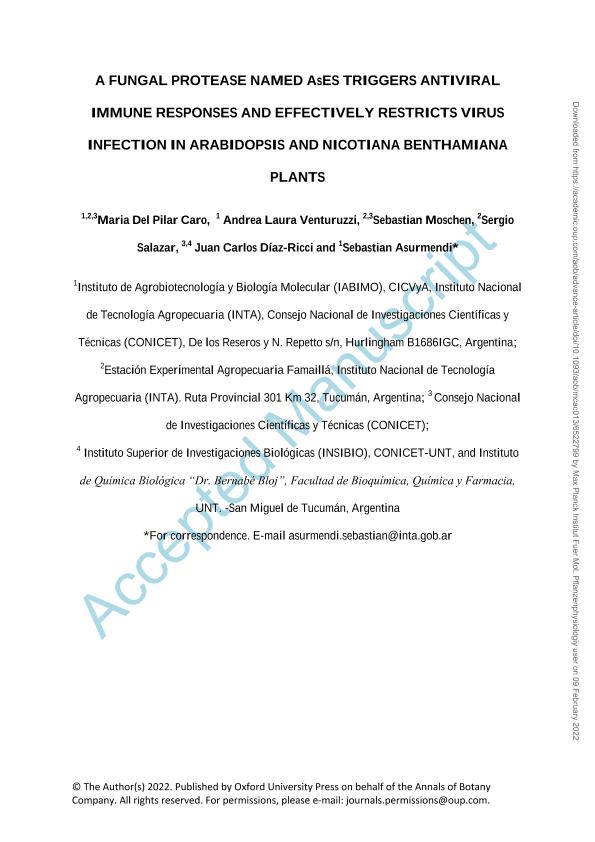Mostrar el registro sencillo del ítem
dc.contributor.author
Caro, María del Pilar

dc.contributor.author
Venturuzzi, Andrea Laura

dc.contributor.author
Moschen, Sebastián Nicolás

dc.contributor.author
Salazar, Sergio Miguel

dc.contributor.author
Diaz Ricci, Juan Carlos

dc.contributor.author
Asurmendi, Sebastian

dc.date.available
2023-09-26T15:22:13Z
dc.date.issued
2022-04
dc.identifier.citation
Caro, María del Pilar; Venturuzzi, Andrea Laura; Moschen, Sebastián Nicolás; Salazar, Sergio Miguel; Diaz Ricci, Juan Carlos; et al.; A fungal protease named AsES triggers antiviral immune responses and effectively restricts virus infection in arabidopsis and Nicotiana benthamiana plants; Oxford University Press; Annals of Botany; 129; 5; 4-2022; 593-606
dc.identifier.issn
0305-7364
dc.identifier.uri
http://hdl.handle.net/11336/213069
dc.description.abstract
Background and Aims: Plants have evolved complex mechanisms to fight against pathogens. Among these mechanisms, pattern-triggered immunity (PTI) relies on the recognition of conserved microbe- or pathogen-associated molecular patterns (MAMPs or PAMPs, respectively) by membrane-bound receptors. Indeed, PTI restricts virus infection in plants and, in addition, BRI1-associated kinase 1 (BAK1), a central regulator of PTI, plays a role in antiviral resistance. However, the compounds that trigger antiviral defences, along with their molecular mechanisms of action, remain mostly elusive. Herein, we explore the role of a fungal extracellular subtilase named AsES in its capacity to trigger antiviral responses. Methods: In this study, we obtained AsES by recombinant expression, and evaluated and characterized its capacity to trigger antiviral responses against Tobacco mosaic virus (TMV) by performing time course experiments, analysing gene expression, virus movement and callose deposition. Key Results: The results of this study provide direct evidence that exogenous treatment with recombinant AsES increases a state of resistance against TMV infection, in both arabidopsis and Nicotiana benthamiana plants. Also, the antiviral PTI response exhibited by AsES in arabidopsis is mediated by the BAK1/SERK3 and BKK1/SERK4 co-receptors. Moreover, AsES requires a fully active salicylic acid (SA) signalling pathway to restrict the TMV movement by inducing callose deposition. Additionally, treatment with PSP1, a biostimulant based on AsES as the active compound, showed an increased resistance against TMV in N. benthamiana and tobacco plants. Conclusions: AsES is a fungal serine protease which triggers antiviral responses relying on a conserved mechanism by means of the SA signalling pathway and could be exploited as an effective and sustainable biotechnology strategy for viral disease management in plants.
dc.format
application/pdf
dc.language.iso
eng
dc.publisher
Oxford University Press

dc.rights
info:eu-repo/semantics/openAccess
dc.rights.uri
https://creativecommons.org/licenses/by-nc-sa/2.5/ar/
dc.subject
BAK1
dc.subject
BKK1
dc.subject
CALLOSE
dc.subject
PLANT IMMUNITY
dc.subject
PROTEASE
dc.subject
SALICYLIC ACID (SA)
dc.subject
TOBACCO MOSAIC VIRUS (TMV)
dc.subject.classification
Biotecnología Agrícola y Biotecnología Alimentaria

dc.subject.classification
Biotecnología Agropecuaria

dc.subject.classification
CIENCIAS AGRÍCOLAS

dc.title
A fungal protease named AsES triggers antiviral immune responses and effectively restricts virus infection in arabidopsis and Nicotiana benthamiana plants
dc.type
info:eu-repo/semantics/article
dc.type
info:ar-repo/semantics/artículo
dc.type
info:eu-repo/semantics/publishedVersion
dc.date.updated
2023-07-06T12:42:16Z
dc.journal.volume
129
dc.journal.number
5
dc.journal.pagination
593-606
dc.journal.pais
Reino Unido

dc.journal.ciudad
Oxford
dc.description.fil
Fil: Caro, María del Pilar. Instituto Nacional de Tecnología Agropecuaria. Centro Regional Tucuman-Santiago del Estero. Estación Experimental Agropecuaria Famaillá; Argentina. Instituto Nacional de Tecnología Agropecuaria. Centro de Investigación en Ciencias Veterinarias y Agronómicas. Instituto de Agrobiotecnología y Biología Molecular. Consejo Nacional de Investigaciones Científicas y Técnicas. Oficina de Coordinación Administrativa Parque Centenario. Instituto de Agrobiotecnología y Biología Molecular; Argentina
dc.description.fil
Fil: Venturuzzi, Andrea Laura. Instituto Nacional de Tecnología Agropecuaria. Centro de Investigación en Ciencias Veterinarias y Agronómicas. Instituto de Agrobiotecnología y Biología Molecular. Consejo Nacional de Investigaciones Científicas y Técnicas. Oficina de Coordinación Administrativa Parque Centenario. Instituto de Agrobiotecnología y Biología Molecular; Argentina
dc.description.fil
Fil: Moschen, Sebastián Nicolás. Instituto Nacional de Tecnología Agropecuaria. Centro Regional Tucuman-Santiago del Estero. Estación Experimental Agropecuaria Famaillá; Argentina. Consejo Nacional de Investigaciones Científicas y Técnicas; Argentina
dc.description.fil
Fil: Salazar, Sergio Miguel. Instituto Nacional de Tecnología Agropecuaria. Centro Regional Tucuman-Santiago del Estero. Estación Experimental Agropecuaria Famaillá; Argentina. Universidad Nacional de Tucumán. Facultad de Agronomía y Zootecnia; Argentina
dc.description.fil
Fil: Diaz Ricci, Juan Carlos. Consejo Nacional de Investigaciones Científicas y Técnicas. Centro Científico Tecnológico Conicet - Tucumán. Instituto Superior de Investigaciones Biológicas. Universidad Nacional de Tucumán. Instituto Superior de Investigaciones Biológicas; Argentina
dc.description.fil
Fil: Asurmendi, Sebastian. Instituto Nacional de Tecnología Agropecuaria. Centro de Investigación en Ciencias Veterinarias y Agronómicas. Instituto de Agrobiotecnología y Biología Molecular. Consejo Nacional de Investigaciones Científicas y Técnicas. Oficina de Coordinación Administrativa Parque Centenario. Instituto de Agrobiotecnología y Biología Molecular; Argentina
dc.journal.title
Annals of Botany

dc.relation.alternativeid
info:eu-repo/semantics/altIdentifier/url/https://academic.oup.com/aob/article/129/5/593/6522799
dc.relation.alternativeid
info:eu-repo/semantics/altIdentifier/doi/http://dx.doi.org/10.1093/aob/mcac013
Archivos asociados
